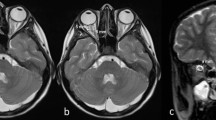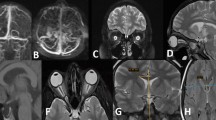Abstract
Purpose
Although several studies have reported imaging findings associated with idiopathic intracranial hypertension (IIH), less is known about the correlation between imaging findings and IIH-related symptoms or signs. Our study aimed to determine if clinical features of IIH are correlated with magnetic resonance imaging (MRI) features.
Methods
A retrospective chart review was conducted on consecutive patients presenting at the neuro-ophthalmology department over the last 15 years. All patients diagnosed with IIH were identified and those with available MRI were included in the final analysis. All MRI images were reviewed by a neuroradiologist blinded to the presenting symptoms and signs. Statistical analysis was performed to determine the correlation between the MRI findings with each clinical symptom or sign.
Results
Thirty-one out of 88 patients with the initial diagnosis of IIH had MRI available and were included in the study. Significant correlations were observed between colour vision and amount of perineural fluid around the optic nerve on MRI (r = − 0.382; p = 0.004), disc assessment and intraocular optic nerve protrusion (r = 0.364; p = 0.004), disc assessment and perineural fluid around the optic nerve (r = 0.276; p = 0.033) and disc assessment and venous sinus stenosis (r = 0.351; p = 0.009).
Conclusion
Our study highlights correlations between imaging and clinical findings of IIH. MRI findings in IIH may be useful in ruling out ominous causes of intracranial pressure and risk stratifying ophthalmologic intervention and management of patients with headaches possibly due to IIH.
Similar content being viewed by others
References
Wall M (2017) Update on idiopathic intracranial hypertension. Neurol Clin 35:45–57. https://doi.org/10.1016/j.ncl.2016.08.004
Shaw AB, Sharma M, Shaikhouni A, Marlin ES, Ikeda DS, McGregor JM, Deogaonkar M (2015) Neuromodulation as a last resort option in the treatment of chronic daily headaches in patients with idiopathic intracranial hypertension. Neurol India 63:707–711. https://doi.org/10.4103/0028-3886.166534
Best J, Silvestri G, Burton B, Foot B, Acheson J (2013) The incidence of blindness due to idiopathic intracranial hypertension in the UK. Open Ophthalmol J 7:26–29. https://doi.org/10.2174/1874364101307010026
McCluskey G, Doherty-Allan R, McCarron P, Loftus AM, McCarron LV, Mulholland D, McVerry F, McCarron MO (2018) Meta-analysis and systematic review of population-based epidemiological studies in idiopathic intracranial hypertension. Eur J Neurol 25:1218–1227. https://doi.org/10.1111/ene.13739
Wall M (2010) Idiopathic intracranial hypertension. Neurol Clin 28:593–617. https://doi.org/10.1016/j.ncl.2010.03.003
Klein A, Stern N, Osher E, Kliper E, Kesler A (2013) Hyperandrogenism is associated with earlier age of onset of idiopathic intracranial hypertension in women. Curr Eye Res 38:972–976. https://doi.org/10.3109/02713683.2013.799214
Andrews LE, Liu GT, Ko MW (2014) Idiopathic intracranial hypertension and obesity. Horm Res Paediatr 81:217–225. https://doi.org/10.1159/000357730
Friedman DI, Liu GT, Digre KB (2013) Revised diagnostic criteria for the pseudotumor cerebri syndrome in adults and children. Neurology 81:1159–1165. https://doi.org/10.1212/WNL.0b013e3182a55f17
Mollan SP, Davies B, Silver NC, Shaw S, Mallucci CL, Wakerley BR, Krishnan A, Chavda SV, Ramalingam S, Edwards J, Hemmings K, Williamson M, Burdon MA, Hassan-Smith G, Digre K, Liu GT, Jensen RH, Sinclair AJ (2018) Idiopathic intracranial hypertension: consensus guidelines on management. J Neurol Neurosurg Psychiatry 89:1088–1100. https://doi.org/10.1136/jnnp-2017-317440
Vimont C (2016) All about the eye chart. Am Acad Ophthalmol https://www.aao.org/eye-health/tips-prevention/eye-chart-facts-history. Accessed 28 Jul 2019
Broadway DC (2012) How to test for a relative afferent pupillary defect (RAPD). Community Eye Health 25:58–59
Rauch K (2017) How color blindness is tested. Am Acad Ophthalmol https://www.aao.org/eye-health/diseases/how-color-blindness-is-tested. Accessed 28 Jul 2019
Hingwala DR, Kesavadas C, Thomas B et al (2013) Imaging signs in idiopathic intracranial hypertension: are these signs seen in secondary intracranial hypertension too? Ann Indian Acad Neurol 16:229–233. https://doi.org/10.4103/0972-2327.112476
Bialer OY, Rueda MP, Bruce BB, Newman NJ, Biousse V, Saindane AM (2014) Meningoceles in idiopathic intracranial hypertension. Am J Roentgenol 202:608–613. https://doi.org/10.2214/AJR.13.10874
Degnan AJ, Levy LM (2011) Pseudotumor cerebri: brief review of clinical syndrome and imaging findings. Am J Neuroradiol 32:1986–1993. https://doi.org/10.3174/ajnr.A2404
Desai PK Idiopathic intracranial hypertension | radiology reference article | Radiopaedia.org. In: Radiopaedia https://radiopaedia.org/articles/idiopathic-intracranial-hypertension-1. Accessed 28 Jul 2019
Bidot S, Saindane AM, Peragallo JH, Bruce BB, Newman NJ, Biousse V (2015) Brain imaging in idiopathic intracranial hypertension. J Neuro-Ophthalmol 35:400–411. https://doi.org/10.1097/WNO.0000000000000303
Maralani PJ, Hassanlou M, Torres C, Chakraborty S, Kingstone M, Patel V, Zackon D, Bussière M (2012) Accuracy of brain imaging in the diagnosis of idiopathic intracranial hypertension. Clin Radiol 67:656–663. https://doi.org/10.1016/j.crad.2011.12.002
Shofty B, Ben-Sira L, Constantini S, Freedman S, Kesler A (2012) Optic nerve sheath diameter on MR imaging: establishment of norms and comparison of pediatric patients with idiopathic intracranial hypertension with healthy controls. AJNR Am J Neuroradiol 33:366–369. https://doi.org/10.3174/ajnr.A2779
Morris PP, Black DF, Port J, Campeau N (2017) Transverse sinus stenosis is the most sensitive MR imaging correlate of idiopathic intracranial hypertension. AJNR Am J Neuroradiol 38:471–477. https://doi.org/10.3174/ajnr.A5055
Sander K, Poppert H, Etgen T, Hemmer B, Sander D (2011) Dynamics of intracranial venous flow patterns in patients with idiopathic intracranial hypertension. Eur Neurol 66:334–338. https://doi.org/10.1159/000331002
Chan W, Neufeld A, Maxner C, Shankar J (2019) Irreversibility of transverse venous sinus stenosis and optic nerve edema post-lumbar puncture in idiopathic intracranial hypertension. Can J Ophthalmol 54:e57–e59. https://doi.org/10.1016/j.jcjo.2018.06.023
Agid R, Farb RI, Willinsky RA, Mikulis DJ, Tomlinson G (2006) Idiopathic intracranial hypertension: the validity of cross-sectional neuroimaging signs. Neuroradiology 48:521–527. https://doi.org/10.1007/s00234-006-0095-y
Acheson JF (2006) Idiopathic intracranial hypertension and visual function. Br Med Bull 79–80:233–244. https://doi.org/10.1093/bmb/ldl019
Chang Y-CC, Alperin N, Bagci AM, Lee SH, Rosa PR, Giovanni G, Lam BL (2015) Relationship between optic nerve protrusion measured by OCT and MRI and papilledema severity. Invest Ophthalmol Vis Sci 56:2297–2302. https://doi.org/10.1167/iovs.15-16602
Raja AS, Andruchow J, Zane R, Khorasani R, Schuur JD (2011) Use of neuroimaging in US emergency departments. Arch Intern Med 171:260–262. https://doi.org/10.1001/archinternmed.2010.520
Komolafe MA, Komolafe EO, Olugbodi AA, Adeolu AA (2006) Which headache do we need to investigate? Cephalalgia Int J Headache 26:87–88. https://doi.org/10.1111/j.1468-2982.2006.0995.x
Razek AAKA, Batouty N, Fathy W, Bassiouny R (2018) Diffusion tensor imaging of the optic disc in idiopathic intracranial hypertension. Neuroradiology 60:1159–1166. https://doi.org/10.1007/s00234-018-2078-1
Hoffmann J, Kreutz KM, Csapó-Schmidt C, Becker N, Kunte H, Fekonja LS, Jadan A, Wiener E (2019) The effect of CSF drain on the optic nerve in idiopathic intracranial hypertension. J Headache Pain 20:59. https://doi.org/10.1186/s10194-019-1004-1
Sarica A, Curcio M, Rapisarda L, Cerasa A, Quattrone A, Bono F (2019) Periventricular white matter changes in idiopathic intracranial hypertension. Ann Clin Transl Neurol 6:233–242. https://doi.org/10.1002/acn3.685
Funding
No funding was received for this study.
Author information
Authors and Affiliations
Corresponding author
Ethics declarations
Conflict of interest
The authors declare that they have no conflict of interest.
Ethical approval
All procedures performed in studies involving human participants were in accordance with the ethical standards of the institutional and/or national research committee and with the 1964 Helsinki declaration and its later amendments or comparable ethical standards.
For this type of study formal consent is not required.
Informed consent
Informed consent was obtained from all individual participants included in the study.
Additional information
Publisher’s note
Springer Nature remains neutral with regard to jurisdictional claims in published maps and institutional affiliations.
Rights and permissions
About this article
Cite this article
Wong, H., Sanghera, K., Neufeld, A. et al. Clinico-radiological correlation of magnetic resonance imaging findings in patients with idiopathic intracranial hypertension. Neuroradiology 62, 49–53 (2020). https://doi.org/10.1007/s00234-019-02288-9
Received:
Accepted:
Published:
Issue Date:
DOI: https://doi.org/10.1007/s00234-019-02288-9




